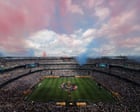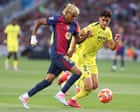
Dynamic pricing, crypto detritus and corporate doublespeak have made the task of buying 2026 World Cup tickets a grim case study in the monetization of emotion
When the first tickets for the 2026 World Cup went on sale last week, millions of fans joined online queues only to discover what Gianni Infantino’s assurance that “the world will be welcome” really means. The cheapest face-value seat for next summer’s final, somewhere in the gods of New Jersey’s 82,500-seat MetLife Stadium where the players are specks and the football’s a rumor, comes at a cost of $2,030 (oxygen tank not included). Most upper-deck seats range from $2,790 to $4,210, according to customers who finally glimpsed the prices that had been closely guarded. The much-touted $60 tickets for group-stage games, propped up by Fifa as evidence of affordability, exist only as comically tiny green smudges on the edge of digital seating maps, little more than mirages of inclusivity.
Fifa had kept the costs under wraps until the very moment of sale, replacing the usual published table of price points with a digital lottery that decided who even got the chance to buy. Millions spent hours staring at a queue screen as algorithms determined their place in line. When access finally came for most, the lower-priced sections had already vanished, many presumably swallowed by bots and bulk-buyers (and that’s before Fifa quietly raised the prices of at least nine matches after only one day of sales). The whole process resembled less a ticket release than a psyop to calibrate how much frustration and scarcity the public will tolerate.
Continue reading…Dynamic pricing, crypto detritus and corporate doublespeak have made the task of buying 2026 World Cup tickets a grim case study in the monetization of emotionWhen the first tickets for the 2026 World Cup went on sale last week, millions of fans joined online queues only to discover what Gianni Infantino’s assurance that “the world will be welcome” really means. The cheapest face-value seat for next summer’s final, somewhere in the gods of New Jersey’s 82,500-seat MetLife Stadium where the players are specks and the football’s a rumor, comes at a cost of $2,030 (oxygen tank not included). Most upper-deck seats range from $2,790 to $4,210, according to customers who finally glimpsed the prices that had been closely guarded. The much-touted $60 tickets for group-stage games, propped up by Fifa as evidence of affordability, exist only as comically tiny green smudges on the edge of digital seating maps, little more than mirages of inclusivity.Fifa had kept the costs under wraps until the very moment of sale, replacing the usual published table of price points with a digital lottery that decided who even got the chance to buy. Millions spent hours staring at a queue screen as algorithms determined their place in line. When access finally came for most, the lower-priced sections had already vanished, many presumably swallowed by bots and bulk-buyers (and that’s before Fifa quietly raised the prices of at least nine matches after only one day of sales). The whole process resembled less a ticket release than a psyop to calibrate how much frustration and scarcity the public will tolerate. Continue reading…





